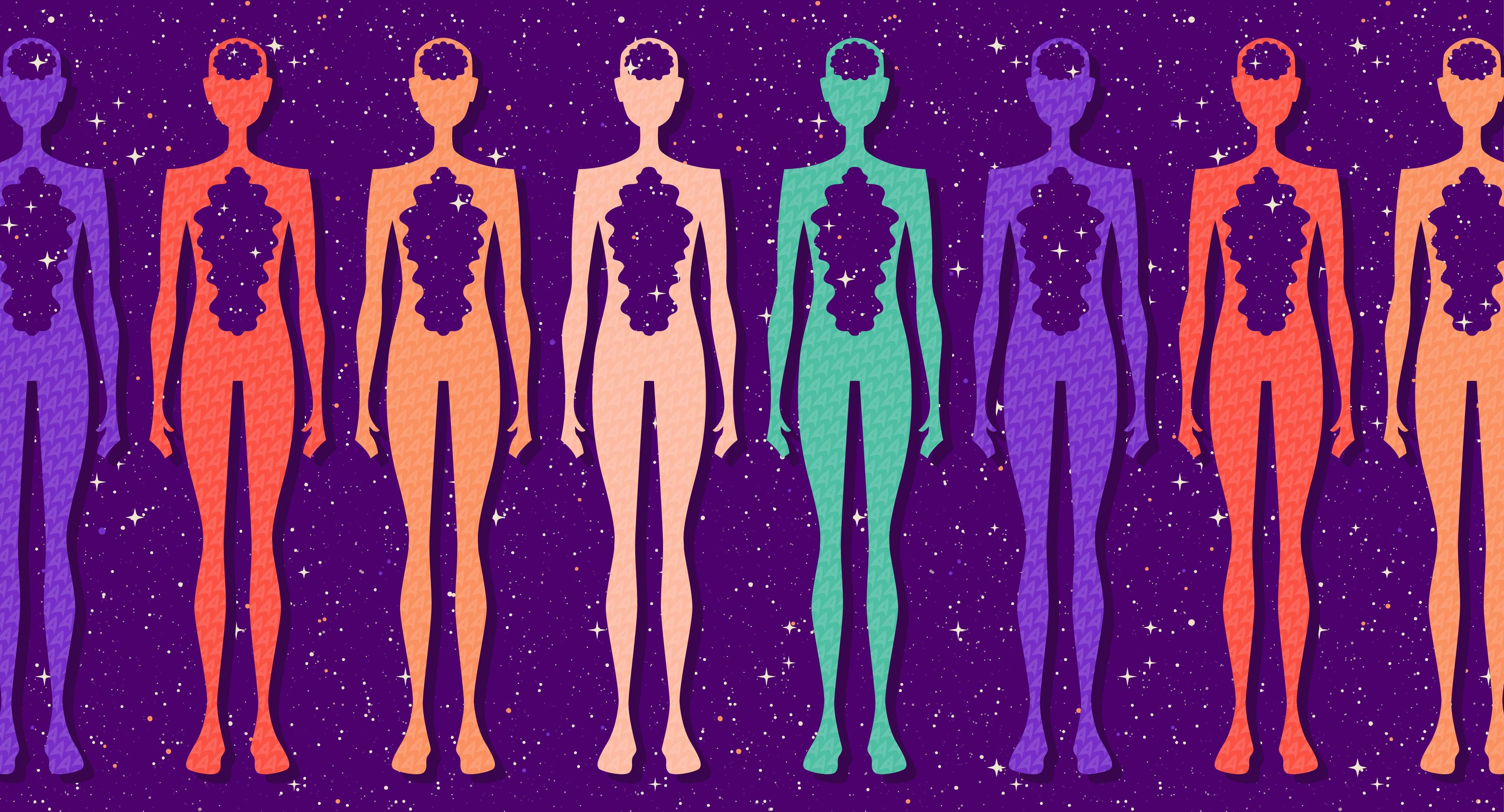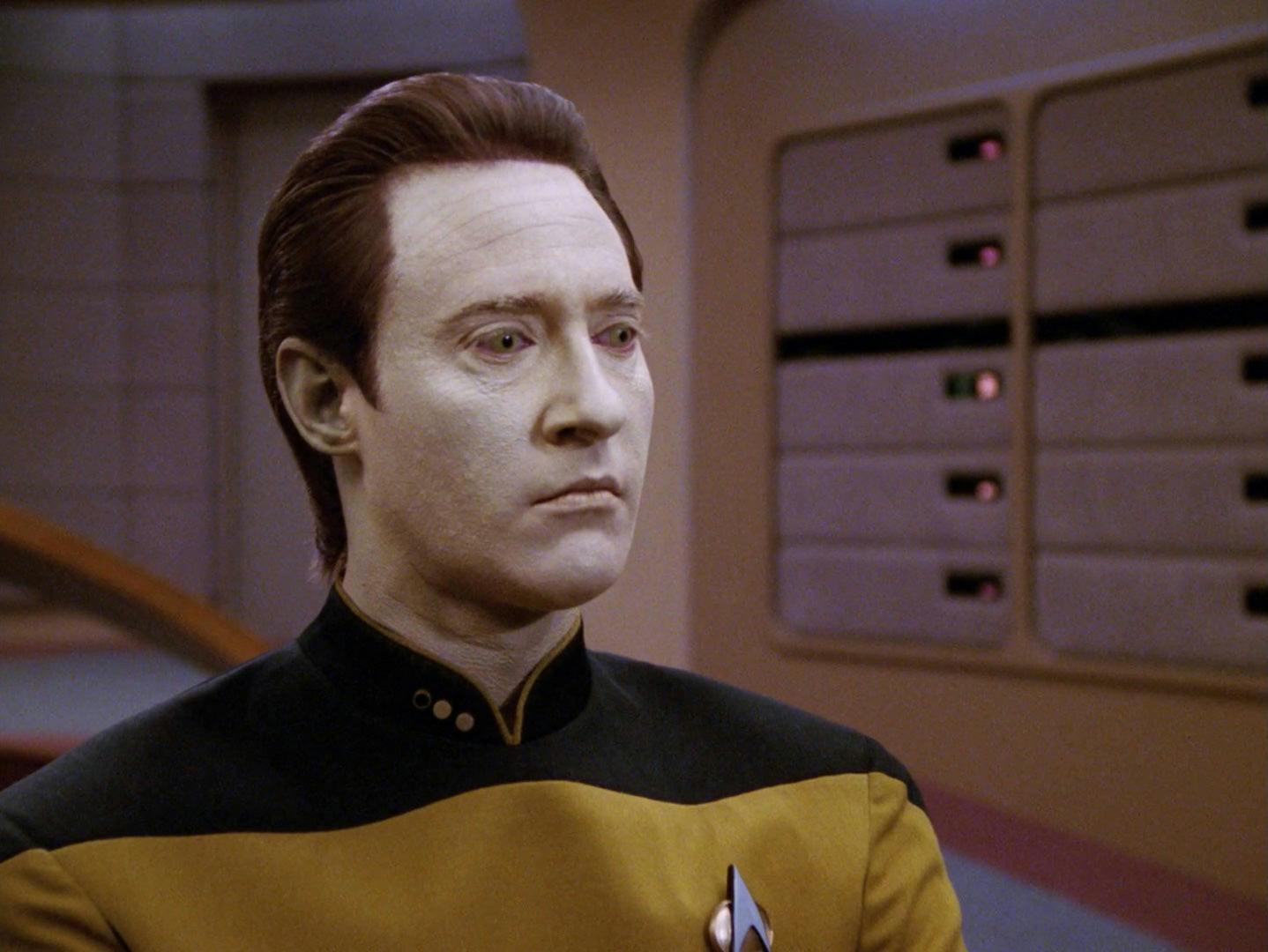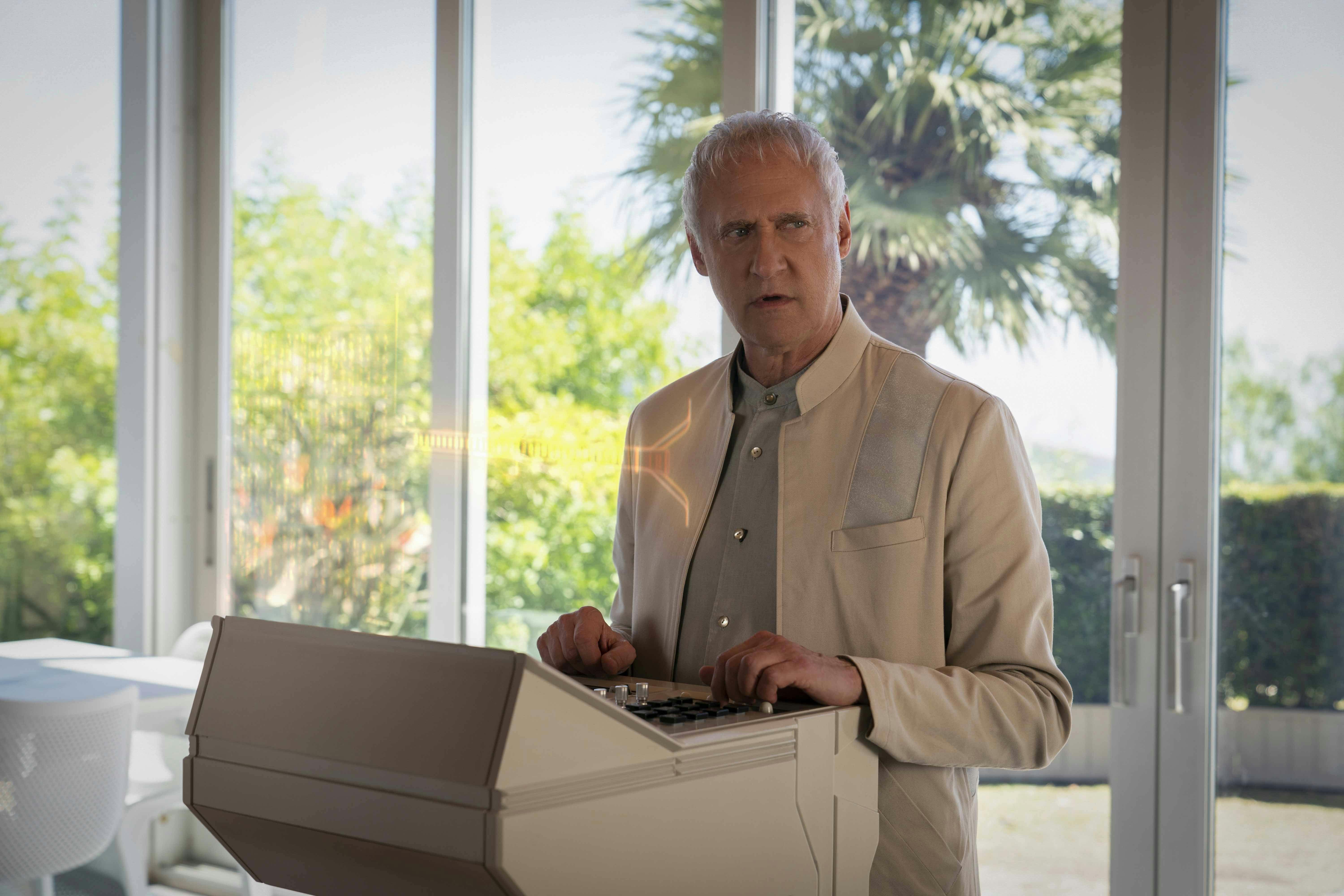
StarTrek.com
The Golem metaphor winds through Jewish stories and popular fiction, from Johann Wolfgang von Goethe’s “Prometheus” to Bride of Frankenstein to Sorcerer’s Apprentice to Lt. Commander Data and Seven of Nine. And in Star Trek, the Golem legend was recently given new life when the canon officially introduced the term “golem,” a type of synthetic organic android functioning nearly identically to a biological lifeform, into the franchise’s lexicon. However, the Golem created by Dr. Altan Inigo Soong in preparation for his death with Dr. Agnes Jurati’s help in Star Trek: Picard is more of a golem-robot hybrid, but that comes as no surprise. The persistent theme of the Golem — unleashed into the universal consciousness by Paul Wegener’s Der Golem, wie er in die Welt Kam silent 1920 expressionist film — appears throughout the Star Trek universe, bringing the legend into the modern century by combining it with the theme of artificial intelligence, or robots—coined by Karel ?apek’s play “R.U.R.,” aka “Rossum’s Universal Robots,” in 1921.
“Here I sit, forming men.” – Goethe.

StarTrek.com
Jewish children are taught about the persecution of our people—to the point of traumatization, if we’re being honest. Vicarious trauma is a time-honored tradition of Jewish babushkas worldwide who drag their Jewish dumplings to pogroms, Holocaust museums, and memorial sites to imagine the historical horrors inflicted on the Jews. But the trauma of being Jewish does not end there: anti-Semitism is alive in America, and it has shaped Star Trek, along with the traditions the Jews brought with them.
“A lot of Jewish tradition—a lot of Jewish wisdom—is part of Star Trek, and Star Trek drew on a lot of things that were in the Old Testament and the Talmud,” adds Star Trek writer David Gerrold in an interview with The New York Times about the Star Trek: Exploring New Worlds exhibit at the Skirball Cultural Center in Los Angeles. “Anyone who is very literate in Jewish tradition is going to recognize a lot of wisdom that Star Trek encompassed.”
Like many children of second-generation Jewish refugees, my family story is akin to many of Star Trek’s greatest legends from Leonard Nimoy and William Shatner — both sons of Ukrainian Jewish immigrants who experienced anti-Semitic slurs firsthand growing up, according to Shatner’s 2016 book Leonard: My Fifty-Year Friendship with a Remarkable Man — to Michael Chabon who inspired to turn Jean-Luc Picard into a Golem in Star Trek: Picard because of the night he snuck into his Uncle Jack’s basement workshop to witness one’s creation for the first time, as the writer recounts in his collection of essays Maps & Legends. (Yes, this story also sounds like Soji’s dream in the episode “The Impossible Box,” as well.) But Star Trek’s story isn’t just about Nimoy or me, or Shatner or Chabon; it’s about the language of the shtetls of Europe and the ghettos of America and growing up Jewish and everything that comes with it. Everyday experiences create a subtext, and those shared experiences can help bind us together.
Although Gene Roddenberry was a humanist, two of his initial co-writers on Star Trek: The Original Series, Bob Justman and Herb Solow, were Jewish. The Shoah influenced several TOS episodes, the Hebrew term referring to Nazi’s systemic, state-sponsored persecution and genocide of more than six million Jews and five million prisoners of war, including at least 20,000 Germans of African descent. After the Shoah, Jewish artists have struggled to find respectful ways of creating and telling stories about the Holocaust as a form of vicarious witnessing and memorializing the Shoah’s victims by preserving their memories through creation. “To forget the dead would be akin to killing them a second time,” says survivor and author Elie Wiesel. To me, Star Trek offers stories of vicarious witnessing. The most obvious example from TOS is “The City on the Edge of Forever,” Kirk, Spock, and Dr. McCoy travel back in time to the first days of World War II. And another way Star Trek has done that is by drawing on the existing Golem legend as a figure of protection (Data, Pre-Corruption Airiam), destruction (the Synth Attack on Mars, Lore), and possible redemption (Soji, Seven of Nine) through its stories of artificial intelligence and the Borg.
“My father had me, but he created Data – a fact he never let me forget.” – Dr. Altan Soong.

StarTrek.com
The Golem is a creature of Jewish folklore, a “lifeless, shapeless mass” imbued with life and built for a specific purpose. First appearing in Psalm 139 of the Hebrew Bible, Adam is referred to as a golmi. He is brought to life by the breath—the word—of G-d, inert matter transformed into vibrant life, like Data, Lore, or any of the Coppelius Station androids. According to Talmudic legend, Adam was the original Golem, a “body without a soul” (Sanhedrin 38b) built for the glory of G-d, crafted in his image. Thus, traditionally only an influential rabbi can create a Golem either by (1) inscribing the word Emeth (truth) on their forehead or (2) placing a parchment piece bearing the word Schem (name) into their mouth.
However, the classic Golem tale dates to 16th-century Prague and tells the story of Rabbi Judah Löew ben Bezalel (an actual historical figure; circa 1520–1609), the Maharal [teacher] of Prague, asking G-d to help him defend the Jewish community from anti-Semitic attacks for blood libel, the accusation Jews needed the blood of Christian babies to make matzoh. G-d instructs Rabbi Löew to collect clay from the Vltava River to bring the Golem to life to protect the Jewish community from harm and anti-Semitic attacks. Although he is successful and takes great pride in his creation serving the synagogue, eventually, the creature takes on a life of its own and runs amok, and the creator pays the price for their act of hubris. To end the Golem’s duties, Rabbi Löew decommissions him by reversing the mystical ritual and sealing its body in the Old-New Synagogue's attic (so-called because it’s the oldest active synagogue in Europe).
Although not the first Golem in Star Trek (there were earlier references in Beta canon), Data is the most widely recognized first Golem, referred to as such in the TNG novel Metamorphosis. Data and Lore were built for the glory of their maker Dr. Noonian Soong, who saw immortality in his creations. These Golems were not created for their own sake. At first, neither was given a purpose of their own or futures under their control and only permitted to exist only if they conform to the wishes of their master. Typically, in Jewish legend, when a Golem determines its purpose — let’s call it hubris — it’s destroyed. However, Data was allowed to detach from his creator and given free will, giving him a soul and the ability to sacrifice himself for Picard rather than run amok.
Following in his father’s footsteps, in the Star Trek: Picard episode “Et in Arcadia Ego, Part 1,” Dr. Soong develops the technology to successfully perform a synaptic transfer to transfer human consciousness into the body of a non-traditional Golem, meaning one not made of clay (an aesthetic decision discussed in the special features on the show’s DVD set). Although Dr. Soong created the Golem in his image, ultimately, the first test subject is Admiral Jean-Luc Picard after dying from Irumodic Syndrome while saving the Coppelius Station androids. To breathe life back into the Admiral, his memories are transplanted into the Golem, at the cost of Dr. Soong’s inability to use it himself. However, suppose the creator’s hubris is the downfall of their creation in Golem folktales. In that case, Dr. Soong’s decision to save Picard instead of himself could be the reason the synaptic transfer worked for the Admiral while failing for so many others.

StarTrek.com
In the Star Trek: Discovery episode “Anomaly,” we learn that transferring consciousness to a Golem eventually became known as the “Soong Method”—but the procedure had a low success rate, leading to it being abandoned by the 32nd century. However, in the same episode, Dr. Culber uses the process to create a synthetic body for Gray, allowing him to incorporate his consciousness in a lifeform separate from Adira Tal. This Star Trek: Discovery scene is impactful as Golem imagery for two reasons. First, it keeps Gray’s transition separate from the creation of his Golem while also imbuing it with the meaning of the creation of man. Second, it shows that we must seek happiness even in the face of unspeakable tragedy; it may stop each of us from running amok.
“Resistance is futile.” – Borg.
The Jewish people assimilated into American culture well enough, at least once they changed their names to complete this process. Scholars disagree on what assimilation means for American Jews, especially on what assimilation means for Jewish women. Some initially believed there would be a straight-line path to assimilation, especially for Jewish women who could intermarry. In contrast, others argued that Jews should adopt new ways to maintain their identity in America. But one thing is clear, Jewish assimilation in the twentieth century has been impacted by shifting American gender norms that are often in conflict with Jewish ideals, according to Riv-Ellen Prell. When thinking about which golems are more likely to run amok, the concepts are often highly gendered, and maybe that’s because of gendered social norms and expectations.

StarTrek.com
Jewish literature and art have only begun to see the emergence of the female Golem. One of those female golems is Seven of Nine, and many Jewish women I've met have connected the character to this concept. And the Golem legend, and how it relates to Borg women, is undoubtedly a story that relates to my life, with my life-saving robot parts worth $40,000 (and hopefully, soon to be available to more endometriosis and chronic pain sufferers). As photographer Yves Gellie pointed out in the exhibition Human Version 2.0, the Golem metaphor is a potent one for understanding how technology shapes female bodies – mainly at the hands of male developers, or as the writer and artist Riva Lehrer says in Golem Girl, “Yet every tale tells us: it is in the nature of a Golem to wake up. To search for the path from being an It to an I.”
Like many disabled women and marginalized genders, Lehrer sees herself in the Golem, describing her body as “a mass… with irregular borders,” denying her the “autonomy that is the birthright of normality.” Like many disabled people, she echoes Hugh the Borg's societal sentiment in moments of despair in her memoir. Her makers (the doctors who created her) have revived her without purpose, at least not any purpose she could call her own. She adds, “I am a Golem. My body was built by human hands.”
Rebecca "Ollie" Kaplan (she/he) is a bigender comic critic and judicial scholar and co-author of Double Challenge: Being LGBTQ and a Minority with his wife, Avery Kaplan. His work can regularly be found at Geek Girl Authority, Comics Beat, Prism Comics, PanelxPanel, and MovieWeb. Her Twitter is @RebeccaKaplan6.
Star Trek: Discovery currently streams exclusively on Paramount+ in the U.S. Internationally, the series is available on Paramount+ in Australia, Latin America and the Nordics, and on Pluto TV in Austria, France, Germany, Italy, Spain, Switzerland and the United Kingdom on the Pluto TV Sci-Fi channel. In Canada, it airs on Bell Media’s CTV Sci-Fi Channel and streams on Crave. Star Trek: Discovery is distributed by Paramount Global Distribution Group.
Star Trek: Picard streams exclusively on Paramount+ in the U.S. and is distributed concurrently by Paramount Global Distribution Group on Amazon Prime Video in more than 200 countries and territories. In Canada, it airs on Bell Media’s CTV Sci-Fi Channel and streams on Crave.
